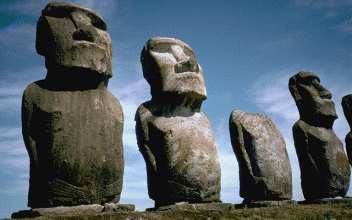 The
Chilling Tale of Easter Island
The
Chilling Tale of Easter Island
About 2,000 miles from the nearest continent,
and 1,400 miles from the next closest inhabited isle, lies a
tiny chunk of land only 65 square miles in size. It is the most
isolated, inhabited place in the world, Easter Island.
When the explorer Jacob Roggeveen found it on
April 5, 1722 (Easter day, henceforth the name), the natives,
numbering about 2,000, had no idea that other peoples, beside
themselves, existed. This is not surprising since the islanders
had no boats or canoes capable of crossing the sea. Roggeveen,
in his log, described the few craft they had as "bad and frail."
What Roggevenn did find surprising was the presence
of 200 haunting stone statues that lined the coast. Some were
as high as 33 feet and weighed 82 tons. Abandoned in quarries
or along roads were another 700 statues, some 65 feet tall and
weighing 270 tons. Roggevenn observed that Easter was a barren
island with no timber for scaffolding or plants for making heavy
ropes. How could such massive monuments be carved and erected
by such a small group of people lacking basic materials?
Many people have pondered the mystery of Easter
Island. Erich von Daniken, the Swiss
writer, insisted that extraterrestrials had constructed the
statues (he also suggested that ancient alien visitors were
responsible for the Egyptian pyramids, Nazca
lines, etc.). Now archaeologists exploring Easter have pieced
together a history that is almost as strange as an alien encounter
and perhaps more frightening.
Archaeologists have done this by taking a "core"
of the ground under a swamp or pond and looking at the pollen
grains found there. Grains are dated by a method known as radiocarbon
dating, and the number of grains found indicate how numerous
the plant was at that particular time in history. Archaeologists
have also examined trash pits left by humans to understand what
they were up to during different periods of Easter Island history.
When the first Polynesians landed on Easter Island,
around 400 to 700 A.D., what they found was far from a barren
land. The Island was a sub-tropical paradise. Thick forests
of palm trees covered the hills. Other plants including the
hauhau tree, which can be used to make ropes, were also numerous.
Seabirds, including the albatross, and boobies, as well as others,
used the Island as a nesting place. Porpoises played in the
waves.
Archaeologists examining bones found in the trash
pits discovered that the main meat diet of these early islanders
consisted of the porpoise, which had to be caught well off-shore
from heavy canoes, and the seabirds.
With conditions so fine on Easter the human population
quickly swelled. Estimates of population range up to 20,000
at its peak. The islanders soon had enough time left over after
mere survival to start building the huge statues that cover
the island. These were probably erected by rival clans each
one wanting to have the largest and most numerous statues as
a sign of status and wealth. The island must have been well
organized because the resources to build the statues were widely
scattered. The best stone for the statues came from one quarry.
The rock for the statues'crowns from another, and the tools
to work the stone yet from another place on the island. Trade
was well developed.
 The
Islanders started chopping down the palm trees to make rollers
and sledges to move the statues. They cut the hauhau trees to
make the ropes needed to pull and erect the monuments. By 1400
the palms were well on their way to becoming extinct, and only
a few of the hauhau trees survived.
The
Islanders started chopping down the palm trees to make rollers
and sledges to move the statues. They cut the hauhau trees to
make the ropes needed to pull and erect the monuments. By 1400
the palms were well on their way to becoming extinct, and only
a few of the hauhau trees survived.
When the last palm was cut down there was no longer
the wood to make the heavy canoes needed for long sea voyages
or to hunt the porpoises that were an important part of the
Islanders diet. With the porpoises gone the people had to turn
even more to the seabirds, and then the rats, as a source of
food. When they were gone, starvation resulted, the government
collapsed and cannibalism appeared. Human bones started to find
their way into trash pits.
By the time Roggeveen arrived it was almost all
over. There were no living animals on Easter except the humans
and a few domesticated chickens. Nothing larger than insects.
And over the barren landscape stood the cold, stone statues,
the strange proof that a great civilization once must have occupied
the island.
What makes this story so frightening? It is a
warning tale to all of us. It is quite possible to wreck a closed
ecological system by overusing it's resources. It happened on
Easter Island and it could happen to our own planet Earth.
All photos on this page are courtesy
of Noe Zamel. Copyright Noe Zamel.

Copyright Lee Krystek
1997. All Rights Reserved.



 The
Chilling Tale of Easter Island
The
Chilling Tale of Easter Island  The
Islanders started chopping down the palm trees to make rollers
and sledges to move the statues. They cut the hauhau trees to
make the ropes needed to pull and erect the monuments. By 1400
the palms were well on their way to becoming extinct, and only
a few of the hauhau trees survived.
The
Islanders started chopping down the palm trees to make rollers
and sledges to move the statues. They cut the hauhau trees to
make the ropes needed to pull and erect the monuments. By 1400
the palms were well on their way to becoming extinct, and only
a few of the hauhau trees survived.
